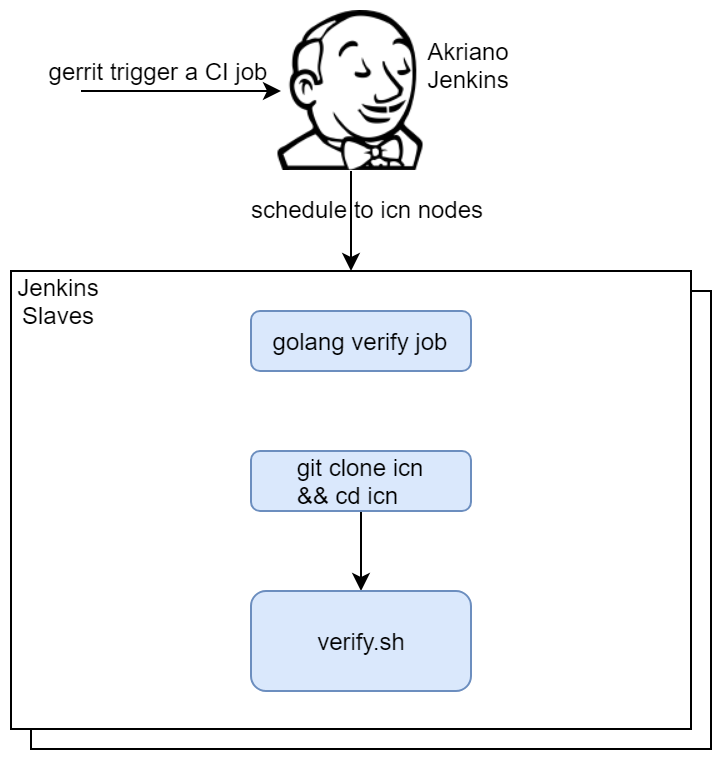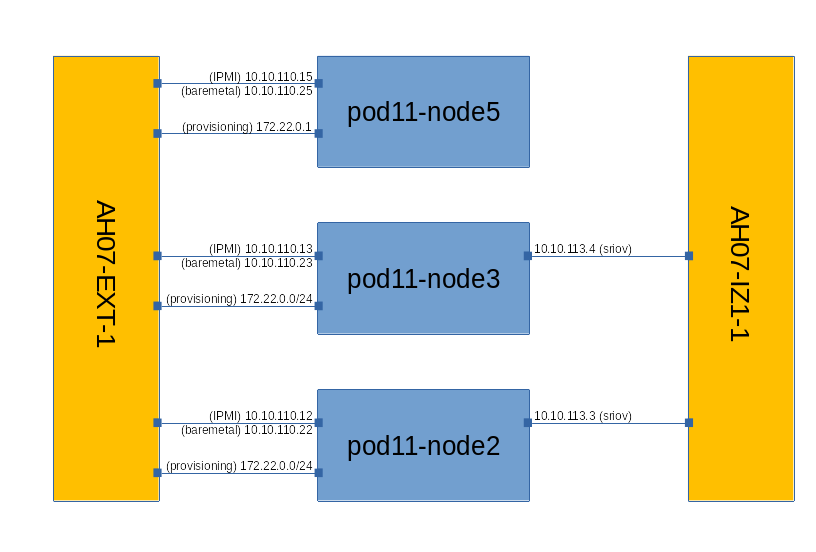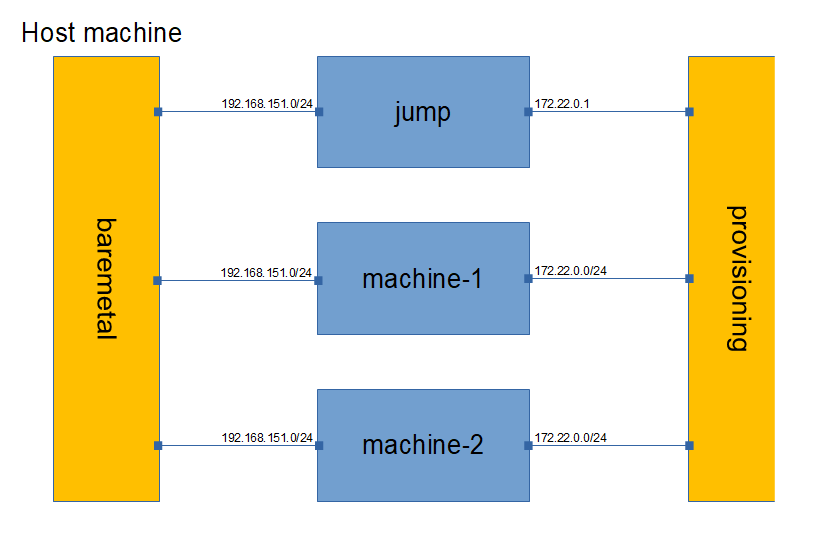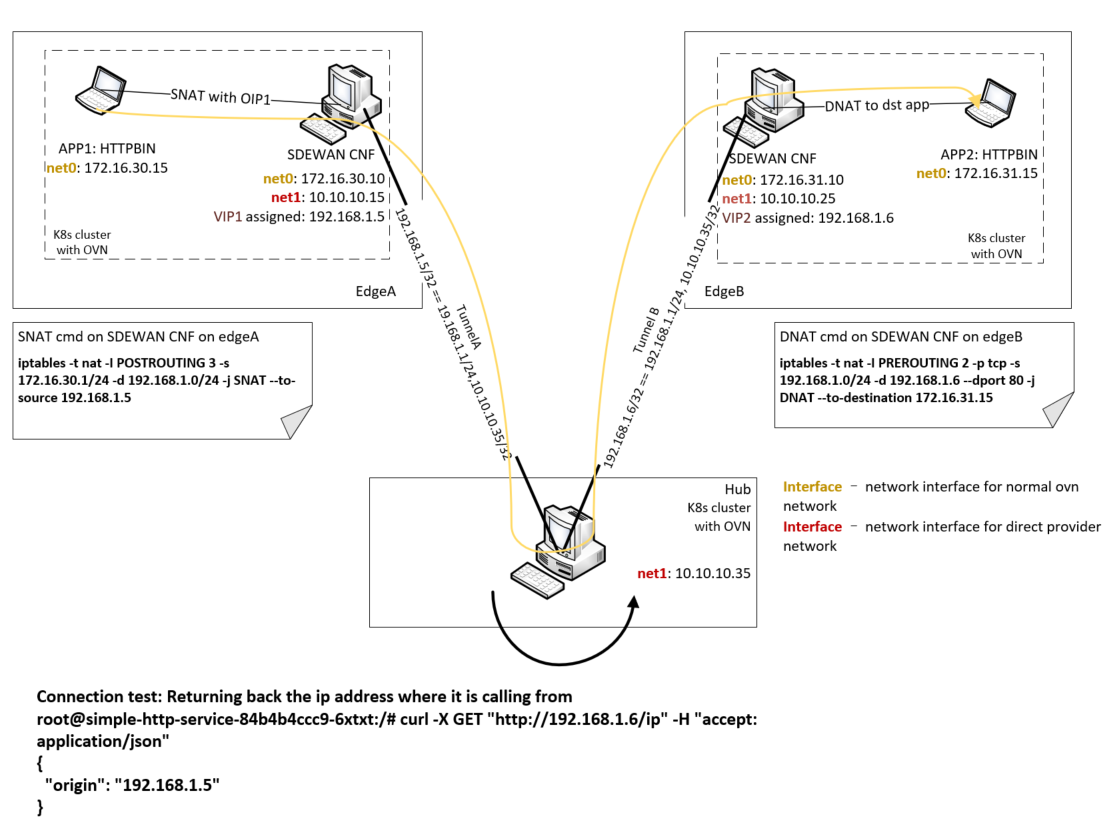Introduction
ICN Pod Topology
Jenkins Information
Akraino community has a public Jenkins cluster. ICN leverages the Akraino public Jenkins to run CI jobs. While the CD jobs run in our private Jenkins cluster.
We have the following Jenkins slave nodes joined Akraino Jenkins. ICN CI jobs are supposed to be scheduled to our slave nodes by label icn-dev.
| Slave Information | Server Information | ||
|---|---|---|---|
| Slave Name | Labels | Slave Root | Server Info |
| prd-ubuntu-dev-44c-64g | icn-dev | /home/jenkins/akraino/slave_root | pod14-node1 |
To add more Jenkins slave nodes, please follow the Akriano Jenkins guide
To setup private Jenkins, please refer to the README.md under icn/ci/
The private Jenkins cluster is setup on pod14-node2. We can visit the Jenkins with the node IP address: http://10.10.140.22:8080/
Currently we support only AIO private Jenkins.
Akraino Test Group Information
not applicable
Overall Test Architecture
Test Architecture
We support the following jobs
CI job
- Triggered by gerrit patch creation/update.
- The job runs verify.sh under ICN project. The verify.sh currently has integrated the bashate test.
- Post +1/-1 for gerrit patch if the build succeeds/fails
- Upload the job log to Nexus server in post-build actions
CD job for test
- Triggered daily automatically (We can also trigger it manually)
- Run a make command, which creates VM(s) and deploys ICN components on the VM(s)
- Upload the job log to Nexus server in post-build actions
CI job detail
Update the verify.sh can update the CI job content.
CD job detail
We have the following steps for CD job:
- On our private Jenkins node, we provision a VM by vagrant. A Vagrantfile which defines the VMs properties is needed. We can define many VM properties in the Vagrantfile:
- VM hostname
- VM memory 40G, CPU 32, disk 400GB
- Login to the VM and run 'make verifier' which installs the components in the VM
- We destroy the VM as the last step of the job
Test Bed
Pod Topology
ICN Master Bare Metal Deployment Verifier
(image source: https://gerrit.akraino.org/r/gitweb?p=icn.git;a=blob;f=doc/pod11-topology.png)
- Baremetal network, lab networking for SSH, it is used as the control plane for K8s, used by OVN and Calico for the overlay networking with Internet access
- Provisioning network used by Ironic to do inspection and serve OS images (Will be having DHCP server)
- IPMI LAN to do IPMI protocols for the OS provisioning
ICN Master Virtual Deployment Verifier
(image source: https://gerrit.akraino.org/r/gitweb?p=icn.git;a=blob;f=doc/vm-topology.png)
- Baremetal network is used as control plane for K8s, used by OVN and Calico for overlay network with NAT's Internet access
- Provisioning network used by Ironic to do inspection and server OS images
- Redfish protocol is executed over baremetal network using sushy-emulator
Bare metal deployment
Hostname | CPU Model | Memory | BMC Firmware | Storage | 1GbE: NIC#, VLAN, (Connected Extreme 480 switch) | 10GbE: NIC# VLAN, Network (Connected with IZ1 switch) | 40GbE: NIC# |
|---|---|---|---|---|---|---|---|
pod11-node5 (jump) | Intel 2xE5-2699 | 64GB | 1.46.9995 | 3TB (Sata) | IF0: VLAN 110 (DMZ) | IF2: VLAN 112 (Private) | |
pod11-node2 | Intel 2xE5-2699 | 64GB | 1.46.9995 | 3TB (Sata) | IF0: VLAN 110 (DMZ) | IF2: VLAN 112 (Private) | |
pod11-node3 | Intel 2xE5-2699 | 64GB | 1.46.9995 | 3TB (Sata) | IF0: VLAN 110 (DMZ) | IF2: VLAN 112 (Private) | IF4: SRIOV |
Virtual deployment
Hostname | CPU Model | Memory | Storage | 1GbE: NIC#, VLAN, (Connected extreme 480 switch) | 10GbE: NIC# VLAN, Network (Connected with IZ1 switch) |
|---|---|---|---|---|---|
pod14-node2 | Intel 2xE5-2699 | 64GB | 3TB (Sata) | IF0: VLAN 110 (DMZ) | IF2: VLAN 112 (Private) |
Test Framework
All components are tested with end-to-end testing
Test description
Testing
CI Testing:
bashate:
The bashate test is to check the shell scripts code style. i.e. trailing white space. We find all files with suffix '.sh' and run bashate against the files.
CD Verifier (end-to-end testing):
All the test case are tested as follows:
Cluster API (infrastructure and bootstrap provisioning):
Verifier will check that servers are provisioned with OS and K8s control plane is ready. The provisioning status is checked every 60 seconds.
Addons:
Test cases verify if the addons are running correctly. Test cases can be found in the ICN deploy/addons, deploy/istio and deploy/kata directories.
Multus:
- Multus CNI is a container network interface (CNI) plugin for Kubernetes that enables attaching multiple network interfaces to pods. This is accomplished by Multus acting as a "meta-plugin", a CNI plugin that can call multiple other CNI plugins.
- A 'NetworkAttachmentDefinition' is used to set up the network attachment, i.e. secondary interface for the pod.
- A pod is created with requesting specific network annotations with bridge CNI to create multiple interfaces. When the pod is up and running, we can attach to it to check the network interfaces on it by running ip a command
Nodus:
- Nodus provide Provider networks using VLAN networking and Service Function Chaining.
- After the pod is up and running we will be able to attach to the pod and check for multiple interfaces created inside the container.
- Nodus networking is setup and created
Nodus Validation and test case results
| Tools | Logs |
|---|---|
| Synk | |
| BDBA | |
| CheckMarx | |
| Fuzzing tool(Radamsa) | |
| Kube-hunter | Kube hunter logs |
| kube-bench | Kube bench logs |
Node Feature Discovery
- Node Feature Discovery for Kubernetes detects hardware features available on each node in a Kubernetes cluster and advertises those features using node labels.
- Create a pod with specific label information in the case the pods are scheduled only on nodes whose major kernel version is 3 and above. Since the NFD master and worker daemonset is already running, the master has all the label information about the nodes which is collected by the worker.
- If the OS version matches, the Pod will be scheduled and up. Otherwise, the Pod will be in a pending state in case there are no nodes with matching labels that are requested by the Pod
SRIOV
- The SRIOV network device plugin is Kubernetes device plugin for discovering and advertising SRIOV network virtual functions (VFs) in a Kubernetes host.
- We first determine which hosts are SRIOV capable and install the drivers on them and run the DaemonSet and register Network Attachment Definition
- On an SRIOV capable hosts, we can get the resources for the node before we run the pod. When we run the test case, there is a request for a VF from the pod, therefore the number of resources for the node is increased.
QAT
- KUD identify if there are QAT devices in the host and decide whether to deploy QAT device plugin into Kubernetes cluster.
- The QAT device plugin discovers and advertises QAT virtual functions (VFs) to Kubernetes cluster.
- KUD assign 1 QAT VF to the Kernel workloads. After the assignment finished, the allocated resources in node description will increase.
CMK
- CPU Manager for Kubernetes provides CPU pinning for K8s workloads. In KUD, there are two test cases for the exclusive and shared CPU pools testing.
EMCO:
- EMCO sanity testing check the health connectivity to EMCO micro services, once it is installed
SDEWAN:
- Use KUD to setup 3 clusters (sdewan-hub, edge-a, edge-b)
- Run the SDEWAN CRD Controller in each clusters.
- Create SDEWAN CNF instance and dummy pod (using httpbin instead) in edge-a, SDEWAN CNF instance and httpbin pod in edge-b
- Create IPSec CR to configure sdewan-hub as responder to provide virtual IP addresses to any authenticated party requesting for IP addresses through SDEWAN CRD Controller.
- Create IPSec CR to configure edge-a and edge-b IPSec configuration to get the IP addresses through SDEWAN CRD Controller.
- Establish edge-a tunnel to sdewan-hub, edge-b tunnel to sdewan-hub, and hub XFRM policies will automatically route traffic between edge-a and edge-b
- Create SNAT CR to establish SNAT rule in edge-a and DNAT CR to establish DNAT rule in edge-b which will enable TCP connection from edge-a to edge-b's httpbin service.
- Verify curl command is successful from edge-a dummy pod (using httpbin instead) to edge-b's httpbin service. The function of the curl command is to return back the ip address of the requester.
BluVal Testing
Release 6 Blueprint Scanning Status
OS Vuls Scan
| OS Lynis Scan
| Kube-Hunter Scan
|
|---|---|---|
See results here Exceptions requested for the following:
| See results here Exceptions requested for the following:
| See results here Pass |
Akraino CVE Vulnerability Exception Request
Akraino BluVal Exception Request
CD logs
ICN Master Bare Metal Deployment Verifier
ICN Master Virtual Deployment Verifier
ICN SDEWAN Master End2End Testing
Test Dashboards
All the testing results are in logs
Additional Testing
not applicable
Bottlenecks/Errata
not applicable



